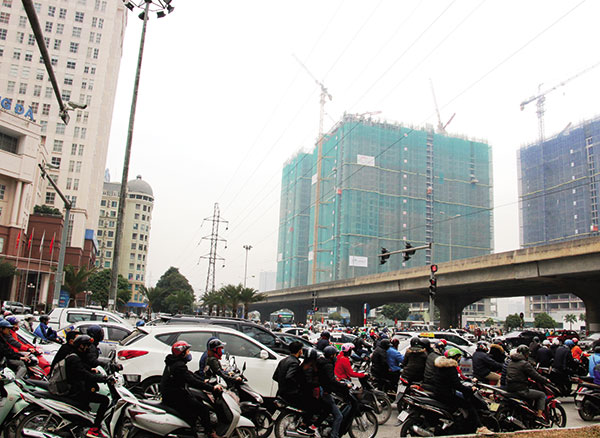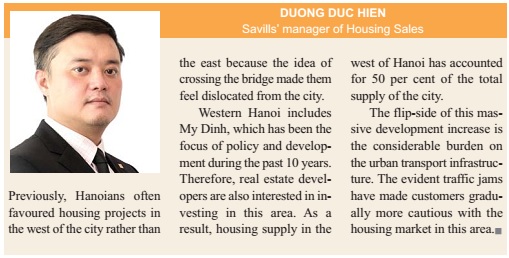Gridlock and smog deter future My Dinh residents
 |
| High-rise construction continues apace in My Dinh, despite slowing demand due to traffic and pollution |
A golden land area
The movement of key state organisations to My Dinh in the past 10 years has been one of the reasons why the area has become much more crowded and valuable. Given its prominent role as a new administrative hub of Hanoi, transportation systems here have been continuously improved. My Dinh is well connected to the west, south, and east areas of the city. There are convenient, diverse routes connecting it to Hanoi’s key roads such as Road 32, Pham Hung, Thang Long, Pham Van Dong, and Belt Road No. 3 from Mai Dich to Thanh Tri.
My Dinh’s urban landscape has changed dramatically since the construction of the National Sports Complex, built to serve the 2003 SEA Games, and later the National Convention Center in 2006.
The headquarters of a number of significant ministries have also been moved to My Dinh, including the Ministry of Public Security, the Ministry of Home Affairs, the Ministry of Natural Resources and Environment, the Ministry of Science and Technology, and the Ministry of Foreign Affairs. In the near future, the Ministry of Agriculture and Rural Development, the Ministry of Transport, and the Ministry of Construction will also relocate to the area.
The strong development of technical and social infrastructure made My Dinh an ideal place for a large series of real estate firms. Accordingly, the value of property in the area increased rapidly.
“In just the past seven to 10 years, housing prices in this area have doubled or tripled,” said Le Quang Manh, director of My Dinh 1 Property Transaction Centre.
“The area is also home to many Korean, Japanese, Singaporean, and British professionals who live and work here. In the past, foreign professionals often stayed in the Trung Hoa urban area, but due to the scarcity of land, the supply was not enough. In the past few years, more expats have moved to the My Dinh area, so apartment rental prices are always high, about $1,000 per month,” he said. “The heavy demand for high-end apartment rental is also the explanation as to why real estate here is always the focus of property developers and investors.”
Manh, however, believes that the density of skyscraper residential projects has made this area cramped. This can be seen by the limited land available for transportation and public entertainment sites surrounding the My Dinh bus station along Pham Hung street.
| The My Dinh area includes My Dinh Ward 1 and My Dinh Ward 2 of Nam Tu Liem district. My Dinh Ward 1 is surrounded by living space alternating between the old residential area and modern high-rise buildings. It is adjacent to My Dinh Ward 2, Me Tri, and Phu Do traditional noodle village. The total population of My Dinh district is approximately 60,000 people. |
Hot traffic jam
Walking along Pham Hung road, we saw numerous housing projects, each boasting thousands of apartments, about to be launched onto the market – such as Hanoi Paragon, The Garden Hill, The Emerald My Dinh, and Scitech Tower.
About 30 high-rise residential buildings have appeared in a radius of one kilometre along Pham Hung which is more than three kilometres in length. The intersection of Me Tri crossing Pham Hung accommodates a dozen of buildings enclosed from four directions.
From Ham Nghi-Nguyen Co Thach to Ham Nghi-Le Duc Tho intersection, within just 500 metres, there are three housing projects HD Moon city, MB land home My Dinh 3 and Sun square with nine high-rise buidings, offering up to 3000 apartments.
Manh said that many vacant land lots will soon be bustling with new high-rise complexes.
“I do not understand why the state licensed so many high-rise buildings in the My Dinh area. Even before the projects have been put into operation, the streets such as Nguyen Hoang, Tran Binh, and Pham Hung from the intersection of Keangnam Landmark to Pham Van Dong have become overloaded,” said Nguyen Thi Loan, a street drink seller in front of the My Dinh bus station on Pham Hung road.
“If you drive along the Pham Hung road at rush hour, near the My Dinh bus station, you only move 10-20cm at a time. Cars, taxis, coaches, and even trucks, carrying construction materials for high-rise buildings, run into each other. There is almost no space left for motorbikes on the road.
“Dust, hot smoke, and noise pollution are creating severe impatience in vehicle owners. People rush to drive along the pavements to get where they need to go. In particular, the traffic situation becomes even more chaotic between 5pm and 5.30pm,” Loan told VIR.
According to statistics dated November 26, 2017 from Hanoi’s Department of Natural Resources and Environment, the city’s roads and construction areas are heavily polluted with dust, vehicular benzene emissions, and noise.
The department’s findings show that most of the monitored sites have benzene levels that are 1.2 to 2.5 times the Vietnam Standards QCVN 06/2009/BTNMT, as well as noise levels that exceed regulations. Hanoi’s most heavily polluted areas are the districts of Ha Dong, Hoang Mai, Cau Giay, and Nam Tu Liem [My Dinh area is part of this district], with high concentrations surrounding Co Nhue crossroad, Long Bien bus stop, Giap Bat bus station, and Cau Dien intersection. However, the worst site of traffic density and jams is that surrounding the My Dinh bus station.
Hanoi’s Department of Transport recently submitted a proposal to the People’s Committee of the city under which My Dinh bus station would be changed into a car park by 2025. However, the proposal is still under the committee’s consideration.
 |
Slower transactions
The abundance of traffic jams and the overcrowded plotting of high-rise residential buildings in My Dinh, which looks to only increase over the next few years as many more apartment buildings are launched to the market, has disheartened many housing buyers.
Forty-eight-year-old Hoang Van Tuan, head of the HR Department of one of the recently relocated ministries, told VIR that while he is considering buying an apartment in My Dinh, he hesitates as there is a lack of space for regular exercise and relaxation here.
Meanwhile, Nguyen Minh Huy, a 50-year-old ministerial official, explained that it takes him up to one hour to cover a mere seven kilometres from his house in Buoi street to his office, which had recently moved to My Dinh.
Despite such a long daily commute, Huy said he preferred to stay in his current apartment, within a low-rise building in Ba Dinh district, to having a new apartment in My Dinh. “My Dinh lacks green parks while my current house is near the Thu Le Park of Ba Dinh district,” he said.
Manh of My Dinh 1 Property Transaction Centre said that many of his clients wanted to buy houses in My Dinh because it reminded them of the Kangnam area of South Korea, but they are afraid of the severe traffic jams and air pollution.
Although the quality of apartments in the area is quite high, the cost varies from $1,300-1,700. The number of actual transactions has slowed down, according to Manh.
“The density of high-rise buildings will intensify, occupying the position of public relaxation space. In addition to paying attention to the utilities and location, our clients are quite interested in surveying traffic jam spots,” he said.
Dang Hong Vo, former Deputy Minister of Natural Resources and Environment, said that Hanoi’s authorities should rebalance the population in My Dinh with appropriate planning of residential building complexes and transport infrastructure.
However, until further reassessment and management of the area is complete, the buses will continue to drive through the city centre, collecting and delivering passengers along Pham Hung street in the absence of traffic regulation enforcement; and residents, pedestrians, and vehicle drivers will continue to breathe the dust that consumes the roads during the thrice-daily rush hour.
What the stars mean:
★ Poor ★ ★ Promising ★★★ Good ★★★★ Very good ★★★★★ Exceptional
Latest News
More News
- Rare, beautiful, sustainable: the mark of iconic real estate (December 19, 2025 | 08:00)
- Owner-occupied housing stabilises, paving the way for new growth cycle (December 18, 2025 | 17:04)
- Unlocking urban potential of smart cities (December 18, 2025 | 16:50)
- Green finance offers 'passport' for Vietnamese construction, building materials firms (December 15, 2025 | 08:00)
- Gamuda Land commit long-term investment (December 12, 2025 | 11:49)
- HITC ties up with Evolution to develop AI and hyperscale data centres in Vietnam (December 11, 2025 | 12:09)
- Real estate deals boom via high-profile names (December 08, 2025 | 11:32)
- Industrial segment shaped by M&As (December 08, 2025 | 08:00)
- The Privé sets the benchmark for luxury real estate (December 05, 2025 | 08:28)
- TD CASA and the rise of bespoke interior design in luxury living spaces (December 03, 2025 | 14:14)

















 Mobile Version
Mobile Version